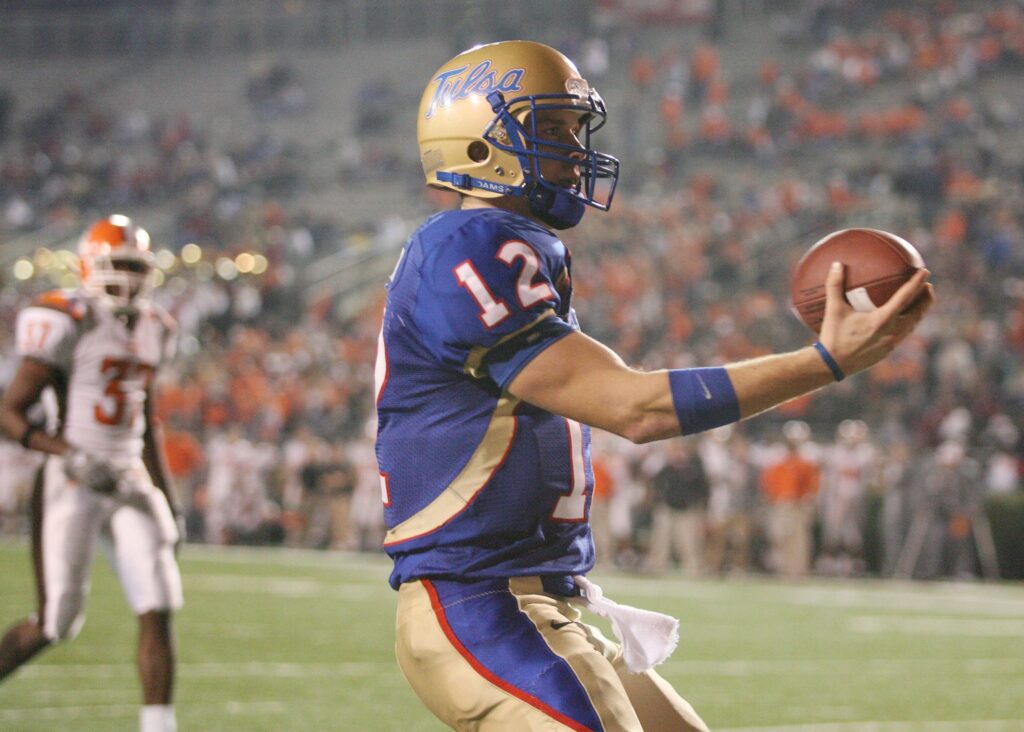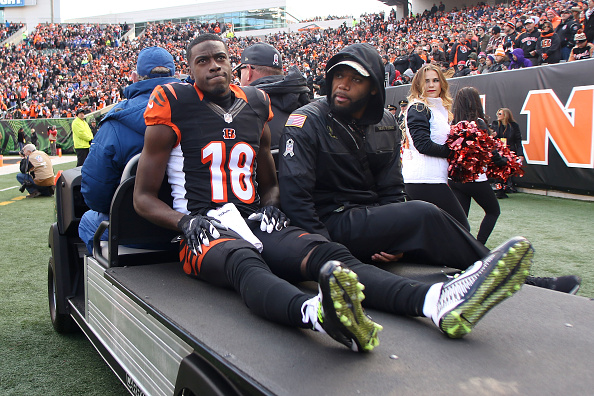The Group of 5/Non-AQ conferences have been home to some serious talent at quarterback. Unfortunately, without NFL success, these quarterbacks may have been lost to history.
College Football is great for a number of reasons. While not everyone could beat anyone on any given Saturday (or Tuesday if you love #MACtion…as you should), when massive underdogs do well, it’s great for the sport. The history of Group of 5 quarterbacks is a storied one but not everyone remembers each one.
Everyone knows how Derek Carr hails from Fresno State and that Case Keenum was ridiculous at Houston, but what about a few others who balled out in college and that’s it? The best thing about the Group of 5 (AAC, Conference-USA, MAC, Sun Belt, and Mountain West as of today) is when it has stars that garner national attention, it’s incredibly fun.
Hopefully, your mind is a steel trap. In any case that it isn’t, let’s remember a few MORE exciting quarterbacks who tore it up.
If it seems like a quarterback was forgotten on this list, perhaps he was covered before.
More Group of 5 Quarterbacks You May Have Forgot
Rakeem Cato, Marshall (2011-2014)
If you are a staunch supporter of the National Arena League, you don’t need any reminder of how much of a dog Rakeem Cato was at Marshall. If not, buckle up.
Cato came to Marshall as an underrated quarterback but immediately made an impact. As a true freshman, Cato appeared in all 13 games for The Herd and threw for 2,059 yards and 15 touchdowns. Even as inexperienced as he was, he completed nearly 60% of his passes. Safe to say, he was just getting started.
In his second year in 2012, Cato took off. Marshall finished just 5-7 on the year, but that didn’t stop the nation from taking note of what The Herd had at quarterback. Cato took off for a career-best 4,201 yards and 37 touchdowns with just 11 interceptions. He led the nation in pass attempts and completions. Those 37 touchdowns were fourth in the nation whereas he threw for the fifth-most. Cato’s season ended with CUSA MVP honors.
As a junior, Cato took a massive step, figuratively and literally. In addition to his 3,916 yards and 39 touchdowns through the air, Cato added 294 yards and six scores on the ground. He led Marshall to its first 10-win season since 2002. What’s even more impressive is he managed to win CUSA Offensive Player of the Year…but only earned Second-Team All-Conference USA honors?
Finally, Cato led Marshall to rarified air in 2014. The Herd finished with a 13-1 mark and was ranked as high as 18th in the CFP rankings. Cato threw for 3,903 yards and 40 touchdowns with 482 yards and eight scores on the ground. When he graduated, Cato threw for at least one touchdown in 46 consecutive games. 46.
That lone loss on the year was a 67-66 absolute slobberknocker of a game against Western Kentucky where Cato threw for a career-best seven touchdowns.
Regardless, Cato finished with program-best 14,079 yards and 131 touchdowns. He led the Herd to three bowl wins, a Conference USA title, and plenty of national respect.
Cato ended up undrafted with concerns with his size. It’s interesting how perspectives have changed because Cato very well could have been a first-rounder this past year since a player like Anthony Richardson went top-four. Richardson may have four inches on Cato but Cato had one thing Richardson didn’t: the ability to play football well.
Ryan Dinwiddie (Boise State, 2000-2003)
Boise State has been at the FBS level for 27 years and they won fewer than 10 games just nine times. Ryan Dinwiddie was among the first signal-callers at the FBS level and achieved the 10-win feat in three out of his four years (two of his three seasons where he started).
In his first season as the full-time starter, Dinwiddie started off strong by passing for 3,043 yards and 29 touchdowns. Despite winning eight games (two of their losses were to AQ/Power 5 teams), Boise State was not invited to a bowl game. That had to have motivated the Broncos because they went on a tear.
In 2002, Dinwiddie suffered a broken ankle and was severely limited in his action. Even then, he threw for 2,283 yards and 20 touchdowns to just three interceptions. Boise State went on to win 12 games and dropped just one to Arkansas.
In his senior season, Dinwiddie and the Broncos kicked it into another gear, going 13-1 and etching their names in history. Statistically, Dinwiddie had his best year, tossing for 4,356 yards and 31 touchdowns. On seven occasions, he threw for more than 300 yards; that includes the two games where he amassed over 500. That lone loss on the season was a 26-24 game against Oregon State where they nearly won if not for a missed field goal in the fourth…and then the Beavers went on a game-ending, 17-play, 66-yard drive that bled out the final 6:42 left.
Dinwiddie was the leader of the Bronco program that was just getting started. He is often regarded as one of the greatest quarterbacks in program history and is still one of the most efficient passers the college game has seen. He finished his career completing 62.7% of his passes with a career efficiency rating of 168.9. That mark is 16th all-time in college football history.
He went undrafted and made a name for himself in the Canadian Football League…as a coach. After retiring after getting cut by the Saskatchewan Roughriders, he picked up coaching. He was a quality control coach for the Montreal Alouettes from 2013-2015, then a quarterbacks coach with the Calgary Stampeders from 2016-2019. He worked with former SMU standout, Bo Levi Mitchell, and won the Grey Cup in 2018.
Now, he’s been the head coach of the Toronto Argonauts since 2020. He led his squad to a Gray Cup victory this past season.
Shaun King (Tulane, 1995-1998)
If you could not remember the Tulane starting quarterback during the mid-to-late 90s, that’s understandable. However, you’d be missing out on quite the story.
Shaun King came to Tulane in 1995 and played right away. As a freshman, King threw for just 1,046 yards and two touchdowns on an offense that struggled all around. To put it into perspective, that Tulane offense finished as the 10th-worst unit in all of college football that year.
As a sophomore, it was not much better. He finished with 1,574 yards and eight scores. In those first two years, Tulane posted a paltry record of 4-18. Then, they hired Tommy Bowden and it all took off.
The 1997 season was the most successful season Tulsa had had since 1980. They finished 7-4 with no bowl invite. Bowden and King improved the offense from 86th in the nation to 14th in scoring. King, himself, took a massive step forward, tossing for 2,567 yards and 24 touchdowns. He was the only player on the team to attempt a pass.
1998 is the season that is to be remembered. If you know who Shaun King was, it was thanks to his efforts in the 1998 season. King’s year was special. At the time, King finished as the most efficient passer in history with his single-season mark of 183.3. It has since been tweaked to 178.7, which is still impressive.
King finished the year throwing for 3,508 yards and 38 touchdowns. With his efforts, Tulane finished as the second most prolific offense in the nation. In the win over Army, King threw for 332 yards and three touchdowns and added 133 yards and three touchdowns on the ground. He was the first Tulane quarterback to achieve the feat as he led his team to its first Conference USA title since 1949.
On the year, Tulane finished a perfect 12-0 after taking down BYU in the Liberty Bowl. King earned a 10th-place finish in Heisman voting and went on to be drafted in the second round of the 1999 NFL Draft by the Tampa Bay Buccaneers.
He spent some time in Tampa Bay, was the primary starter for the franchise’s 2001 NFC South championship year where they nearly made it to the Super Bowl, and was a backup for the Super Bowl XXXVII victory. After bouncing around the NFL and CFL after that, King has coached at the high school level in Florida and is currently the running backs coach for USF.
Paul Smith (Tulsa, 2003-2007)
Finally, from Tulane to Tulsa. If you were a fan of one of the teams Paul Smith went nuclear on during the 2007 season, maybe it’s best you look away.
In his first season on campus, Smith was primarily a backup where he passed for just 197 yards and a touchdown. 2004 came and went and Smith did not appear in any games for the Golden Hurricanes in order to preserve his redshirt. That was the calm before the storm.
Smith started off the 2005 season rough with a less-than-stellar outing against Minnesota. After that, it seemed like Smith was good for at least 200 yards and a score on any given day. He averaged 232 yards a game over the next 12, including the bowl win over Florida State. Smith went on a run of scoring at least once in each of the last 11 games. In total, he ended up with 2,835 yards and 20 touchdowns in his first year as the starter.
It was more of the same in 2006 for Smith. He ended up amassing 2,727 yards and 15 touchdowns. On one hand, he was held to fewer than 200 yards five times, but he did have his first-career 300-yard game in a loss to Rice. He was impressively efficient in ’06, completing 66.6% of his passes on the year.
2007 was legendary. Smith was nearly unstoppable and he helped his team end up with three 1,000+ yard receivers. No seriously, look it up! Smit tore up defenses left and right and had his way with every defense. He scored at least twice in every single game. In total, Smith finished with a whopping 5,065 yards (13th-most in a single season in FBS history) and 47 touchdowns. On four occasions, he threw for five touchdowns, including the 63-7 absolute beatdown of Bowling Green in the GMAC Bowl.
Smith won the Conference USA Player of the Year award after that fantastic season. He finished his career with 14 straight 300+ yard passing games, all of which were in the 2007 season.
After Tulsa, Smith went undrafted and was signed by the Jacksonville Jaguars. He was later cut to make room for Todd Boeckman. If you’re an Ohio State fan, you’ll remember that name…and shiver. After Jacksonville, he signed with the Montreal Alouettes but was cut shortly after. He has since retired from the game.
Main Image: John David Mercer-USA TODAY Sports



